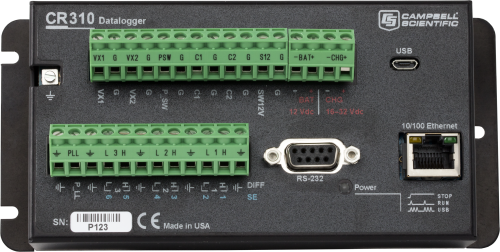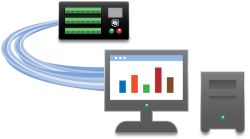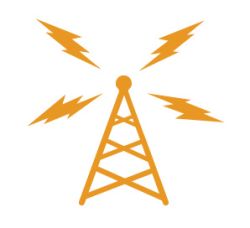
Ideal para muchas aplicaciones






Resumen
El CR310 es un datalogger multipropósito para medida y control, compacto, de bajo coste, que tiene integrado puerto 10/100 Ethernet y borneros removibles. Este datalogger de gama básica, con su potente conjunto de instrucciones programables, puede medir la mayoría de sensores para hidrología, meteorología, medioambiente e industria. Como concentrador de datos, los pone a disposición a través de variedad de redes de telecomunicaciones y protocolos. El CR310 tiene capacidad de tomar decisiones, perfecto en aplicaciones para control y comunicaciones M2M. El CR310 es ideal para aplicaciones remotas básicas de monitorización y control a largo plazo.
Las principales diferencias entre el CR300 y CR310 son que el CR310 dispone de borneros removibles y conectividad 10/100 Ethernet integrada.
El CR310 dispone también como opción la posibilidad de incluir radiomodem:
- CR310-RF407: US y Canadá
- CR310-RF412: Australia y Nueva Zelanda
- CR310-RF422: Europa
- CR300-RF427: Brazil
Nota: Campbell Scientific no recomienda utilizar el CR310 como un PakBus router en redes con más de 50 dispositivos. Arrays de gran tamaño o variables tipo string pueden exceder los limites de su memoria. Para estas aplicaciones recomendamos utilizar el CR1000X Measurement and Control Datalogger
Leer másVentajas y características
- Fácil configuración mediante software PC y la conectividad USB
- Medir con confianza sensores analógicos y digitales
- Preparado para Internet – email, FTP, HTTP/web, TCP, ModBus (CR310 por GPRS/3G y EtherNet, CR300 sólo GPRS/3G)
- Confíe en la calidad Campbell Scientific, incluye protecciones contra transitorios y ESD
- Ahorro de dinero y espacio con el puerto Ethernet integrado
- Opción radio para comunicaciones inalámbricas con otos nodos de la red, y puerta de enlace a Internet
- CR310-WIFI ideal for short-range, wireless IP communication
- Comunicaciones desde cualquier lugar mediante modems telefonía móvil o satélite
- Carga de batería de 12V por panel solar o adaptador corriente, mediante el propio regulador de carga integrado
- Medida de smart sensors por RS-232 o SDI-12
- Conectividad protocolos comunicaciones PakBus, Modbus, DNP3, GOES, y otros
- Análisis y control programables, múltiples I/O de propósito general
- Generar notificaciones y comunicaciones en función de eventos y salidas físicas
Descripción detallada
Descripción de los terminales
- Salida 12 V (SW12V) programable, para alimentación sensores o dispositivos comunicaciones, 1100 mA @ 20°C
- Dos salidas excitación sensores 0.15 a 5 V (VX1, VX2) para alimentación sensores o salida control
- Seis terminales de entrada multipropósito (SE1 - SE6)
- Funciones analógicas (SE1 - SE6)
- Entradas analógicas: 6 single-ended o 3 diferenciales rango entrada de -100 a +2500 mV y ±34 mV, 24 bit ADC
- Entradas 4 a 20 mA o 0 to 20 mA (sólo SE1, SE2)
- Funciones digitales I/O (SE1 - SE4) consistente en niveles lógicos de 3.3 V para:
- Contador alta frecuencia (35 kHz)
- Modulación ancho de pulso
- Interrupciones y timer
- Promediado período (200 kHz, depende de la amplitud)
- Funciones analógicas (SE1 - SE6)
- Dos terminales contadores (P_SW, P_LL)
- P_SW
- Cierre de contacto (150 Hz)
- Contador alta frecuencia (35 kHz)
- P_LL
- ac bajo nivel (20 kHz)
- Contador alta frecuencia (20 kHz)
- P_SW
- Dos terminales de control (C1, C2): los terminales C son configurables por software para funciones digtales
- Las funciones digitales I/O consisten en niveles lógicos entrada/salida de 5 V y 3.3 V para:
- SDI-12
- Contador alta frecuencia (3 kHz)
- Cierre de contacto (150 Hz)
- Estado/control general
- Salida 5 V: 10 mA @ 3.5 V
- Interrupciones
- Comunicaciones asíncronas serie par Tx/Rx
- Las funciones digitales I/O consisten en niveles lógicos entrada/salida de 5 V y 3.3 V para:
Especificaciones
| -NOTE- | Additional specifications are listed in the CR300-Series Specifications Sheet. |
| Operating Temperature Range |
|
| Maximum Scan Rate | 10 Hz |
| Case Material | Powder-coated aluminum |
| Analog Inputs | 6 single-ended or 3 differential (individually configured) |
| Pulse Counters | 8 (P_SW, P_LL, C1, C2, and SE1 to SE4) |
| Voltage Excitation Terminals | 2 (VX1, VX2) |
| Communications Ports |
|
| Switched 12 Volt | 1 terminal |
| Digital I/O | 7 terminals (C1, C2, P_SW, and SE1 to SE4) configurable for digital input and output. Includes status high/low, pulse width modulation, external interrupt, and communication functions. Exception: The SE4 terminal doesn't do external interrupt. |
| Input Limits | -100 to +2500 mV |
| Analog Voltage Accuracy |
|
| ADC | 24-bit |
| Power Requirements | 16 to 32 Vdc for charger input (CHG) (Current limited to 0.9 A maximum for power converter or solar panel input.) |
| Power Requirements | 10 to 18 Vdc for external batteries (BAT) |
| Real-Time Clock Accuracy | ±1 min. per month |
| Internet Protocols | Ethernet, PPP, RNDIS, ICMP/Ping, Auto-IP(APIPA), IPv4, IPv6, UDP, TCP, TLS (v1.2), DNS, DHCP, SLAAC, NTP, Telnet, HTTP(S), FTP(S), SMTP/TLS, POP3/TLS |
| Communication Protocols | PakBus, Modbus, DNP3, SDI-12, TCP, UDP, and others |
| CPU Drive/Programs | 80 MB serial flash |
| Data Storage | 30 MB serial flash |
| Idle Current Drain, Average | 10 mA (@ 12 Vdc with Ethernet link idle) |
| Active Current Drain, Average | 56 mA (@ 12 Vdc with Ethernet link active, processor always on) |
| Dimensions | 16.26 x 7.62 x 5.68 cm (6.4 x 3.0 x 2.2 in.) |
| Weight | 288 to 306 g (0.64 to 0.68 lb) depending on communication option selected |
CR310-RF407 Option |
|
| Radio Type | Frequency Hopping Spread Spectrum (FHSS) |
| Output Power | 5 to 250 mW (user-selectable) |
| Frequency | 902 to 928 MHz (US, Canada) |
| RF Data Rate | 200 kbps |
| Receive Sensitivity | -101 dBm |
| Antenna Connector | RPSMA (external antenna required; see www.campbellsci.com/order/rf407 for Campbell Scientific antennas) |
| Idle Current Drain, Average | 12 mA (@ 12 Vdc) |
| Active Current Drain, Average | < 80 mA (@ 12 Vdc) |
CR310-RF412 Option |
|
| Radio Type | Frequency Hopping Spread Spectrum (FHSS) |
| Output Power | 5 to 250 mW (user-selectable) |
| Frequency | 915 to 928 MHz (Australia, New Zealand) |
| RF Data Rate | 200 kbps |
| Receive Sensitivity | -101 dBm |
| Antenna Connector | RPSMA (external antenna required; see www.campbellsci.com/order/rf412 for Campbell Scientific antennas) |
| Idle Current Drain, Average | 12 mA (@ 12 Vdc) |
| Active Current Drain, Average | < 80 mA (@ 12 Vdc) |
CR310-RF422 Option |
|
| Radio Type | 868 MHz SRD 860 with Listen Before Talk (LBT) and Automatic Frequency Agility (AFA) |
| Output Power | 2 to 25 mW (user-selectable) |
| Frequency | 863 to 870 MHz (European Union) |
| RF Data Rate | 10 kbps |
| Receive Sensitivity | -106 dBm |
| Antenna Connector | (External antenna required; see www.campbellsci.com/order/rf422 for Campbell Scientific antennas.) |
| Idle Current Drain, Average | 9.5 mA |
| Active Current Drain, Average | 20 mA |
CR310-RF427 Option |
|
| Radio Type | Frequency Hopping Spread Spectrum (FHSS) |
| Output Power | 5 to 250 mW (user-selectable) |
| Frequency | 902 to 907.5 MHz/915 to 928 MHz (Brazil) |
| RF Data Rate | 200 kbps |
| Receive Sensitivity | -101 dBm |
| Antenna Connector | RPSMA (External antenna required.) |
| Idle Current Drain, Average | 12 mA (@ 12 Vdc) |
| Active Current Drain, Average | < 80 mA (@ 12 Vdc) |
CR310-WIFI Option |
|
| Operational Modes | Client or Access Point |
| Operating Frequency | 2.4 GHz, 20 MHz bandwidth |
| Antenna Connector | Reverse Polarity SMA (RPSMA) |
| Antenna | pn 16005 unity gain (0 dBd), 1/2 wave whip, omnidirectional with articulating knuckle joint for vertical or horizontal orientation |
| Transmit Power | 7 to 18 dBm (5 to 63 mW) |
CR310-CELL205 Option |
|
| -NOTE- | The CR310-CELL205 option is not compatible with a Verizon cellular network. |
| Cell Technologies |
|
| 3G Frequency Bands | 850, 1700/2100 (AWS), and 1900 |
| 4G Frequency Bands | 700, 850, 1700/2100 (AWS-1), 1900 |
| Antenna Connector | SMA (External antenna required; see www.campbellsci.com/order/cr310 for Campbell Scientific antennas.) |
| SIM Interface |
3FF (6 position/contacts) Supports SIMs that require 1.8 or 3 V. |
CR310-CELL210 Option |
|
| -NOTE- | The CR310-CELL210 option is only compatible with a Verizon cellular network. CR310-CELL205 Option No |
| Cell Technologies | 4G (LTE CAT-1) |
| 4G Frequency Bands | 700, 850, 1700, 1900, 2100 |
| Antenna Connector | SMA (External antenna required; see www.campbellsci.com/order/cr310 for Campbell Scientific antennas.) |
| SIM Interface |
3FF (6 position/contacts) Supports SIMs that require 1.8 or 3 V. |
CR310-CELL215 Option |
|
| -NOTE- | The CR310-CELL215 option is intended for use in EMEA countries. |
| Cell Technologies |
|
| 2G Frequency Bands | 900 and 1800 MHz |
| 3G Frequency Bands | 850, 900, and 2100 MHz |
| 4G Frequency Bands | 800, 850, 900, 1800, 2100, and 2600 MHz |
| Antenna Connector | SMA (External antenna required; see www.campbellsci.com/order/cr310 for Campbell Scientific antennas.) |
| SIM Interface |
3FF (6 position/contacts) Supports SIMs that require 1.8 or 3 V. |
CR310-CELL220 Option |
|
| -NOTE- | The CR310-CELL220 option is intended for use in Australia and New Zealand. |
| Cell Technologies |
|
| 3G Frequency Bands |
|
| 4G Frequency Bands |
|
| Antenna Connector | SMA (External antenna required; see www.campbellsci.com/order/cr310 for Campbell Scientific antennas.) |
| SIM Interface |
3FF (6 position/contacts) Supports SIMs that require 1.8 or 3 V. |
CR310-CELL225 Option |
|
| -NOTE- | The CR310-CELL225 option is intended for use in Japan. |
| Cell Technologies | 4G (LTE CAT-1) |
| 4G Frequency Bands | 800 (lower), 800 (upper), 850+, 900, 1800, and 2100 MHz |
| Antenna Connector | SMA (External antenna required; see www.campbellsci.com/order/cr310 for Campbell Scientific antennas.) |
| SIM Interface |
3FF (6 position/contacts) Supports SIMs that require 1.8 or 3 V. |
Compatibilidad
Nota: lo siguiente muestra información de compatibilidad notable. No es una lista de todos los productos compatibles.
Software
| Producto | Compatible | Nota |
|---|---|---|
| DevConfig | Version 2.12 or higher | |
| LNDB | Version 1.3 or higher | |
| LoggerLink | Version 1.5 or higher | |
| LoggerNet | Version 4.4 or higher | |
| LoggerNet Mobile Connect | Version 1.1 or higher | |
| PC200 (retired) | Version 4.4 or higher | |
| PC400 | Version 4.4 or higher | |
| RTDAQ | ||
| Short Cut | Version 3.2 or higher |
Información de compatibilidad adicional
Periféricos medida y control
El CR310 no se usa habitualmente con nuestros periféricos de medida y control, dado el limitado número de puertos de control. Es compatible con relés de estado sólido que se activen por voltaje y muy bajo amperaje.
El CR310 no es compatible con nuestros periféricos SDM o CDM.
Sensores
El CR310 es compatible con la mayoría de sensores. Esto incluye sensores con salida de voltaje (0 a 2.5 V), corriente (0 a 20 mA o 4 to 20 mA), termistores, y RTDs entre otros. También compatible con sensores que tengan salida de pulsos o frecuencia, como anemómetros, pluviómetros, y medidores de flujo. En el puerto RS232 y en el par C1/C2 (Tx/Rx), podemos medir sensores que comuniquen mediante SDI-12, Modbus, y otros sensores serie. El CR300 no soporta directamente sensores RS485 (requiere interface adicional).
Comunicaciones
El CR310 puede comunicar de forma directa con un PC por el puerto USB o el RS232. Los dispositivos de comunicaciones compatibles son nuestro conversor RS-485, modem/router telefonía móvil 2G/3G/4G, radiomodem, y modem satélite. Los datos pueden visualizarse también en un dispositivo iOS, Android, o display CD295 DataView II. Para dispositivos iOS o Android, visite Apple Store o Google Play y descargue gratuitamente nuestra App LoggerLink Mobile.
| Data Logger Option | Communications Type | Integrated Communications Are Compatible with |
|
CR310-WIFI |
2.4 GHz, 20 MHz bandwidth |
Most other Wi-FI devices, such as the CR300-WIFI, CR6-WIFI, NL240 |
|
CR310-RF407 |
902 to 928 MHz Frequency Hopping Spread Spectrum |
|
|
CR310-RF412 |
915 to 928 MHz Frequency Hopping Spread Spectrum |
|
|
CR310-RF422 |
868 MHz SRD860 LBT+AFA |
|
|
CR310-CELL |
2G Frequency Bands 850, 900, 1800, 1900 |
GSM/GPRS/EDGE (2G) |
Software
La serie CR300 es compatible con CRBasic (versión 3.6 o superior)
Alimentación
El CR310 requiere alimentación externa y tiene integrado un regulador de carga para batería recargable. Internamente selecciona de forma automática el voltaje de alimentación más alto de las tres posibles fuentes de entrada (Chg, Bat, o USB) para funcionar en uno de los siguientes cuatro modos:
- UPS (recomendado) - se utiliza una fuente externa de 16 a 32 Vdc, panel solar (SP10, SP20), para recargar batería de 12 V, como nuestra BP7 o BP12.
- batería de 12 Vdc u otra fuente fiable de 12 Vdc
- solo CHG - fuente de alimentación DC (16 a 32 Vdc)
- USB - alimentación 5Vdc por el puerto USB, para configuración, programación y verificaciones (no recarga batería ni amplifica alimentación del puerto USB para proporcionar 12Vdc en el terminal SW12)
Armarios
En la mayoría de aplicaciones basadas en el CR310, será suficiente nuestro armario ENC10/12 o ENC12/14.
Documentos
Folletos producto
Manuales
Documentos técnicos
Conformidad
Misceláneo
Videos & Tutoriales
Descargas
CR300 Series OS v.11.00 (4.93MB) 21-02-2024
This download is for the CR300 series of dataloggers including all CR300 and CR310 models. Execution of this download places the Operating System file(.obj) on your computer. It also updates the CRBasic Editor compiler and support files.
Why Update? This OS fixes issues related to the TX325/TX326, SDI12Recorder and the addition of MQTT along with other fixes and new features. See the revision history for a complete list. With this OS update, it is recommended that you also update the Device Configuration Utility to the most recent version so that new datalogger features are available in the utility.
Note/Warning: Campbell Scientific always recommends updating operating systems on site if possible. When remote updates are required, it is recommended that you implement the necessary precautions to handle unexpected OS upload complications. All datalogger settings should be retained when updated remotely. If you choose to roll back to a previous operating system, the datalogger settings will be reset to default.
Watch the Video Tutorial: Sending an OS to a Local Datalogger.
CR300 Series Wifi OS Update v.1.7.12 (1.97 MB) 13-05-2022
Manufacturer chipset maintenance update.
CR300 QuickStart Program (569 KB) 15-03-2016
The CRBasic program referenced in the CR300 QuickStart videos and manual.
Data Logger Wiring Excel Template (1 KB) 26-03-2024
This is a data logger wiring diagram spreadsheet template that accompanies the Wiring Diagram Video. The spreadsheet includes templates for CR6, CR1000X, CR300, CR310, and CR350 data loggers. The file is an Excel template and works best with Microsoft Excel.
Preguntas frecuentes
Número de FAQs relacionadas con CR310: 1
Casos de aplicación
Solar energy is the most abundant clean energy source available on earth, but the intermittent......leer más
The Port of Townsville Limited (POTL) are undertaking the Channel Upgrade Project (CU Project). The......leer más
The Panama Canal was using an outdated water-level system until the Panama Canal Authorities (ACP)......leer más


















































































